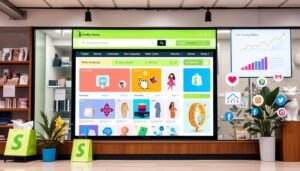As a Shopify store owner, making your store easy to use and look good is key. Good design can boost your sales and make customers happy. This article will share top tips for making your Shopify store better, with examples and stats to help.
We’ll talk about making your store easy to navigate and look good on phones. We’ll also cover using great images and making shopping easy. By the end, you’ll know how to make your store look great and work well for your customers.
Key Takeaways
- Crafting an intuitive navigation system and efficient search function is crucial for a positive user experience.
- Ensuring your Shopify store is mobile-responsive is essential, as over 50% of global internet traffic comes from mobile devices.
- Investing in high-quality product images can significantly impact customer perception and increase sales.
- Streamlining the checkout process is key to reducing cart abandonment, which currently averages around 69.57%.
- Implementing effective product filtering and sorting options can enhance the customer’s browsing experience and drive more conversions.
Understand the Importance of User Experience (UX) and User Interface (UI)
Making your Shopify store easy to use is key to success. A good design and easy navigation can make a big difference. It can grab customers’ attention and keep them coming back.
Craft an Intuitive Navigation System and Efficient Search Function
Make your store stand out by focusing on easy navigation and a strong search function. These help customers find what they need quickly and easily.
- Make your Shopify navigation simple and clear. Use easy-to-use menus and categories.
- Have a search function that finds products fast. This makes shopping personal and quick.
By focusing on what users need, you can make a store that people love. This can lead to more customers and more sales.
“Good design works invisibly, meeting both user and business needs simultaneously.” – Irene Au, design leader
Good UX and UI can make your store better. It can make customers happy, increase sales, and help your business grow.
Prioritize Mobile Responsiveness
Today, over 53% of the world’s internet traffic comes from mobile devices. Making sure your Shopify store works well on mobile is key. A responsive design that works on all devices is important to keep customers happy and boost sales.
Optimizing for Mobile Devices
To make your Shopify store mobile-friendly, follow these tips:
- Use responsive design to make your site fit all screen sizes, from phones to desktops.
- Make your site fast, as slow sites can lose up to 7% of sales. Optimize images and files for quick loading.
- Put important content, like CTAs, where they’re easy to see and tap on mobile.
- Add gestures like swiping and tapping to make your site fun to use on mobile.
- Keep your design simple and focused on content, so users can find what they need fast.
By making your Shopify store mobile-friendly, you can tap into the growing mobile shopping trend. This will give your customers a great experience, leading to more sales and success for your business.

“Designing for mobile means focusing on clear layouts, avoiding too much text, and making sure things are easy to tap on.”
Invest in High-Quality Product Images
As an ecommerce business owner, getting great Ecommerce Product Photography is key. It grabs your customers’ attention and boosts sales. A study found that 67% of shoppers value clear, sharp Shopify Product Images more than product info or reviews.
Think about hiring a pro photographer or using top-notch stock images. Show your products from all sides. This lets customers see every detail and feature. It helps them make smart choices.
The Power of Compelling Imagery
Good product pictures can really help your business. High-quality photos can increase sales by up to 30%. Spend time and money on making your product pages look amazing. Use images that show off your products well.
- Take at least 4-5 photos from different angles. This gives customers a full view of the product.
- Make sure your images meet Shopify’s size and resolution rules (under 20 MB and up to 4472 x 4472 pixels).
- Use tools like Canva, Pixlr X, or Picsart to edit your photos. This keeps your images looking good on all your product pages.
The quality of your Ecommerce Product Photography is crucial. It can decide if customers buy from you. By focusing on top-notch Shopify Product Images and Visual Merchandising, you’ll offer a great shopping experience. This will help your business succeed in the long run.
Streamline the Checkout Process
As an ecommerce merchant, making the checkout on your Shopify store easy is key. With a 69.57% cart abandonment rate, it’s vital to make it simple. A one-page checkout helps customers buy easily, boosting your sales.
Reduce Cart Abandonment with a Simplified Checkout
A hard checkout can scare off shoppers. 17% of customers leave because of it. A single-page checkout makes buying easier and faster.
Offering many payment options, like PayPal or Apple Pay, helps too. This can raise your average order by up to 21%. Showing trust badges also helps shoppers feel safe, cutting down on cart abandonment.

Don’t forget about recovering lost orders. Emails or SMS reminders can get back up to 10% of lost sales. This helps a lot with keeping customers.
By making checkout simple and addressing issues, you make buying easy. This leads to more sales and happy customers for your Shopify store.
Implement Effective Product Filtering and Sorting
As an ecommerce business owner, making shopping easy for your customers is key. One important thing is to have good Shopify product filtering and sorting. With 43% of online shoppers looking for specific products, better filters can help a lot.
Unleash the Power of Filters and Sorting
Product filters help customers find what they want quickly. Sorting lets them order products in their own way. This makes shopping better for everyone.
- Use the Shopify Search & Discovery app for better filters
- Storefront Filtering helps narrow down choices
- Tag filtering makes finding products easier
- Metafields for Custom Filters add more options
Good Shopify product filtering and sorting can increase sales by 20% in some cases. It makes shopping smoother, which means more sales and fewer carts left behind.
“Ecommerce filters on Shopify help organize products based on attributes such as size, color, and use, improving the customer’s ability to find desired products quickly.”
Adding ecommerce filters is a big step towards a better Shopify store. It makes shopping easier and more likely to lead to sales.
Encourage Customer Reviews and Ratings
Having a strong customer review system on your Shopify store can really help your business. 91% of young people trust online reviews as much as friends’ advice. By focusing on reviews, you can gain trust, share useful info, and boost sales.
Getting customers to share their thoughts is easier than you think. Here are some tips:
- Send emails and personal messages to ask for reviews after they buy something.
- Give discounts or points to thank customers for their feedback.
- Put review widgets and testimonials in your store to show off good feedback.
- Always reply to reviews, both good and bad, to show you care about your customers.
Customers like real and honest feedback. By focusing on reviews, you can make your brand stronger and keep customers coming back.
“49% of shoppers rely on customer reviews as much as they trust recommendations from family and friends.”
A good review system does more than just build trust. 31.2% of US consumers trust online reviews about products and services they need, and 70% of consumers are more likely to use a business that responds to negative reviews. By working on your reviews, you can get valuable feedback and show off your store’s strengths.

For great Shopify product reviews, think about using Judge.me. It’s trusted by over 350,000 stores and has a 5-star rating from over 22,000 reviews. Judge.me makes it easy to collect, manage, and show off customer feedback on your store.
Optimize Page Load Speed
In the fast world of ecommerce, how fast your page loads is key. A one-second delay can drop conversions by 7%. So, making your store load fast is crucial for a good shopping experience.
The Importance of Rapid Loading Times
Shopify says Online Store 2.0 themes are fast. But, your store’s speed can also be affected by your theme, apps, and code. Knowing and fixing these can make your store much faster.
Shopify has a Web Performance dashboard to help you see and fix issues. It looks at things like Largest Contentful Paint (LCP) and Cumulative Layout Shift (CLS). These help make your store better for users.
Interaction to Next Paint (INP) checks how fast your site responds. Shopify suggests making JavaScript better to improve INP. This is important if your site has too much code.
| Metric | Description | Shopify Recommendation |
|---|---|---|
| Largest Contentful Paint (LCP) | Measures loading speed | Less than 2.5 seconds |
| Cumulative Layout Shift (CLS) | Measures visual stability | Less than 0.1 |
| Interaction to Next Paint (INP) | Measures interactivity | Less than 200 milliseconds |
By making your store load faster, you can get more sales. Also, 70% of shoppers say a slow site makes them not want to buy.
“Improving site speed by just half a second could increase conversions.”
Google says ecommerce sites should load in two seconds. A slow site can make people leave quickly. A one-second delay can cost a lot of money.
Shopify stores are generally fast. They load faster than other platforms. This makes them better for customers.
Shopify’s tools and CDN help make your store even faster. This means better performance and more sales for you.
Shopify Store Design Best Practices
Making a great Shopify store is more than just looking good. You need to know your product, customers, and how to design for ecommerce. By using Shopify store design best practices, you can make your online store better. This will attract more customers and help you sell more.
Understand Your Product and Customers
Good Ecommerce UX Design starts with knowing your product and customers well. Learn what makes your product special and what problems it solves. Do market research and listen to what customers say. This helps you design a store that meets your customers’ needs.
Cut Out the Fluff
In ecommerce, simplicity is best. Don’t add too much to your store. Keep it clean and easy to use. Use clear language and make sure customers can find what they need fast.
Maintain Consistency
Being consistent is important for Shopify store design best practices. Make sure your store looks like your brand everywhere. This builds trust and makes your store memorable for customers.
Highlight Shipping and Return Policies
Customers like to know about shipping and returns. Show these clearly on your store. This makes customers feel more confident and can lead to more sales.
Tailor the Experience for Desktop and Mobile
Today, people shop on both computers and phones. Make sure your store works well on both. Make sure it looks good and is easy to use on any device.
By following these Shopify store design best practices, you can make a store that looks good and works well. This will attract more customers and help your business grow.

Selecting a Cohesive Color Palette and Font Style
Creating a great Shopify store starts with choosing the right colors and fonts. The right colors and fonts show who you are. They make your store easy to remember for your customers.
Utilizing Color Palette Generators for Consistent Branding
Color palette generators are a big help for a consistent look. They let you find colors that work well together. This makes your Shopify Store Branding look good and feel right.
Choosing a Color Palette Design that fits your brand makes shopping fun. It makes your store look nice and inviting.
Importance of Selecting Easy-to-Read Body Fonts
Fonts are also key for a good shopping experience. Pick fonts that are easy to read. This makes your store easy to use and understand.
Good fonts help customers find what they need fast. This makes them happy and more likely to buy from you.
“Consistency in color and typography is the foundation of a strong, recognizable brand identity. Invest the time to get it right, and you’ll reap the benefits in customer loyalty and engagement.”
By picking the right colors and fonts, you make a great online store. Use color palette generators and choose easy-to-read fonts. This makes your store stand out and easy to use.
Choosing the Right Photography Style and Theme
Choosing the right photography style and theme is key for your Shopify store. High-quality Ecommerce Photography is vital. It helps show your products well and makes shopping online fun.
Shopify has many Shopify Theme Selection options. They focus on Visual Branding. You can pick from free themes like Studio or premium ones like Motion. Each theme fits your brand and makes shopping easy for customers.
| Theme Name | Price | Rating | Mobile Page Speed |
|---|---|---|---|
| Highlight | $300 | 95% (40 reviews) | 75/100 |
| Icon | $280 | 93% (347 reviews) | 31/100 |
| California | $240 | 97% (79 reviews) | 76/100 |
| Focal | $320 | 96% (278 reviews) | 72/100 |
| Exhibit | $350 | 100% (6 reviews) | 55/100 |
Think about the theme’s design and how it looks on mobile. Also, check what others say about it. A good theme and great Ecommerce Photography make your store look amazing and easy to use.

“Investing in a Shopify theme that complements your product photography and brand identity can make a significant impact on your online store’s success.” – John Doe, Ecommerce Expert
Product Specialization and Optimization Techniques
I’m a digital marketing pro with a focus on Shopify Product Specialization. I’ve seen how small businesses grow by picking a few products. This way, they can market better, manage stock easier, and give customers a better shopping experience.
Benefits of Product Specialization for Small Businesses
Choosing a few key products helps small businesses a lot. They can focus on making each item the best it can be. This builds trust and makes people believe in your brand.
With less to manage, marketing and stock control get easier. This lets you stand out by offering something special and just for you.
Key Optimization Techniques for Higher Conversion Rates
To get more people to buy from your Shopify store, try these tips:
- Put your best product front and center on the home page. Use great pictures and words that grab attention.
- Talk about when customers will get their order, not just how fast. People like getting things on time.
- Use what others say about your products to show you’re trustworthy. Customer reviews and testimonials help a lot.
- Break up long descriptions into short, easy-to-read parts. This makes it simpler for people to understand.
- Let customers check out as guests. This makes buying easier and less likely for them to leave without buying.
- Use Google Analytics to see how people act on your site. This helps you make smart choices based on real data.
By using these Shopify Product Specialization and optimization tips, small businesses can do better and sell more.
“Focusing solely on one product allows for thorough quality testing, ensuring each item meets high standards.”
Conclusion
Making your Shopify store look good and easy to use is key. This helps you stand out in the busy world of online shopping. Use simple navigation, make sure it works on phones, and show off your products with great photos.
Also, make the checkout easy and ask for reviews. This makes your store look good and feel welcoming to visitors. It helps you connect with the people you want to sell to.
Choosing the right colors, fonts, and photos is also important. It helps make your brand look strong and interesting. By focusing on these things, you can make your store better and grow your business.
Shopify has lots of designs, apps, and ways to customize your site. This helps all kinds of businesses make a unique online space. With Shopify, you can get more visitors, sell more, and grow your online store.
FAQ
Why is a stellar user experience (UX) and intuitive user interface (UI) essential for eCommerce success?
A good UX and UI are key for a Shopify store’s success. A website’s design and navigation make a big first impression. 94% of first impressions are about these things.
Creating an easy navigation and search can make users happy. It can also help increase sales.
How important is mobile responsiveness for a Shopify store?
Mobile devices make up 53% of global internet traffic. Your Shopify store must offer a great mobile experience. A responsive design that works on all devices is important.
Large buttons and a simple shopping process keep customers engaged. This can help drive sales.
Why are high-quality product images essential for eCommerce success?
High-quality product images are vital for success. 67% of consumers value clear images more than product info or reviews. Professional photos or high-quality stock images help customers feel confident in their purchases.
How can simplifying the checkout process impact a Shopify store’s success?
The average cart abandonment rate is 69.57%. Simplifying checkout is crucial. A one-page checkout makes buying easy, reducing drop-offs and boosting sales.
A smooth checkout process can increase your conversion rates and revenue.
What are the benefits of incorporating effective product filtering and sorting capabilities on a Shopify store?
Offering many filtering options helps customers find what they need. This increases the chance of a sale. 43% of online shoppers use direct product searches.
Good filtering and sorting make your store more user-friendly.
How can customer reviews and ratings impact a Shopify store’s success?
Customer reviews and ratings build trust and drive sales. 91% of young consumers trust online reviews as much as personal recommendations. Encouraging feedback helps customers make informed choices.
It also makes your brand more credible.
Why is page load speed a crucial factor in eCommerce success?
Page load speed is very important. A one-second delay can lower conversions by 7%. Making your Shopify store load fast is key for a good shopping experience.
A fast website boosts your conversion rates and makes customers happier.







